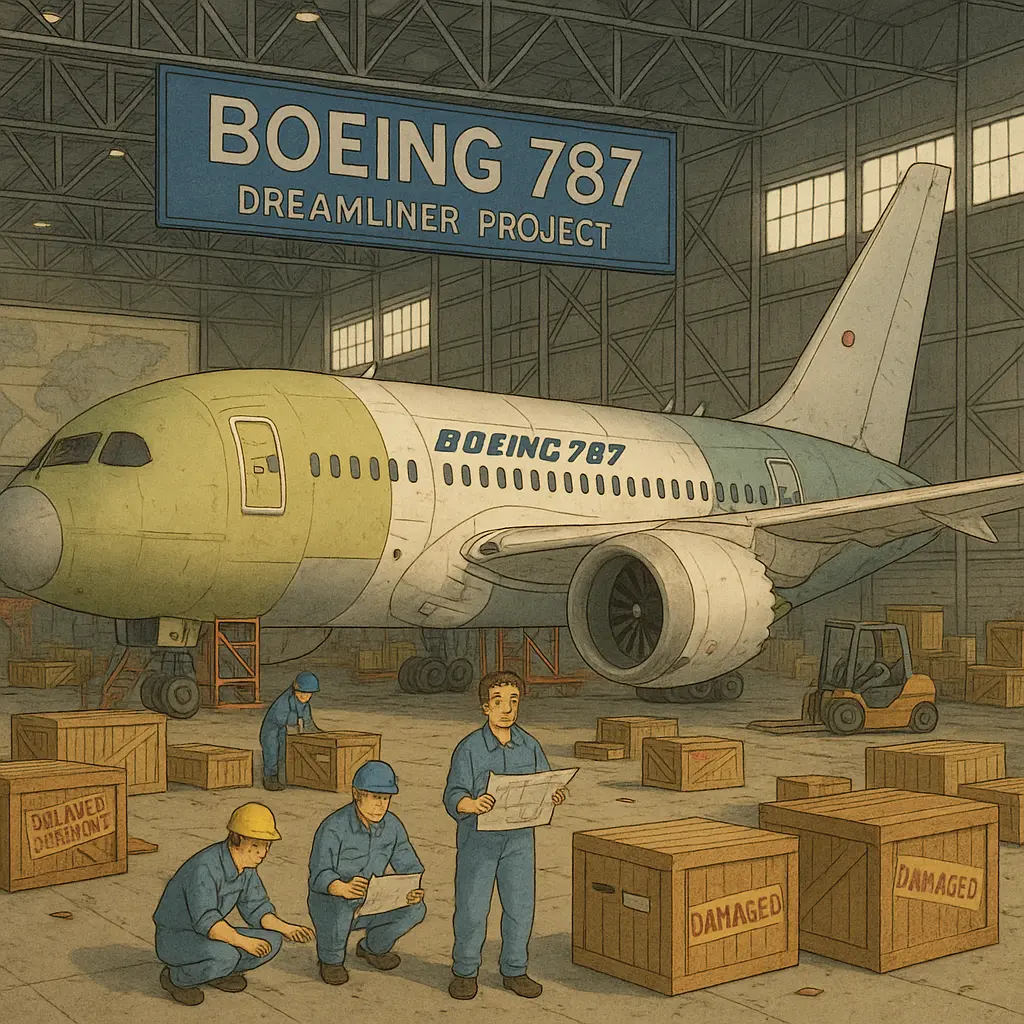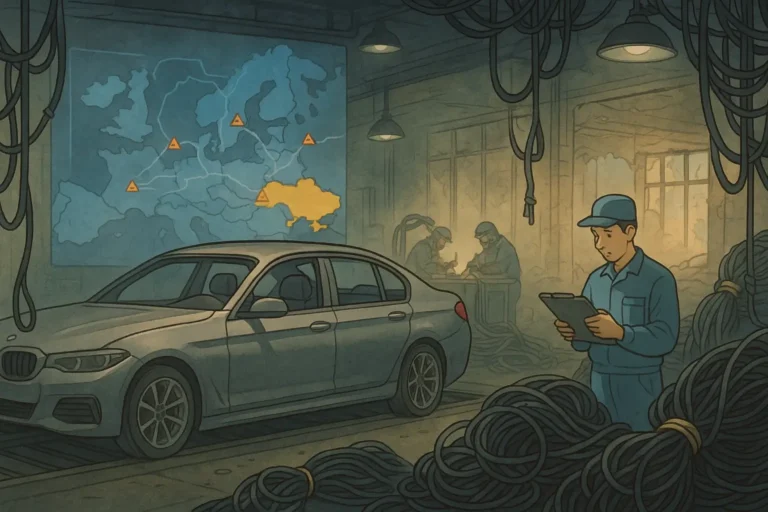
Boeing 787 outsourcing woes
Boeing 787’s outsourcing woes began when the company chose to break tradition and outsource the majority of the 787’s design and manufacturing work to a network of over 50 suppliers around the world.
The move made sense on paper, but in reality, it turned out to be a disaster.
Article Brief & Key Nuggets
- Boeing outsourced an unprecedented 60–70% of its Dreamliner program’s design and manufacturing.
- The result was three years of Boeing 787 Dreamliner delays (2007–2011), billions in overruns, and damaged credibility.
- The plan collapsed due to a shortage of fasteners, incomplete assemblies, inadequate oversight, and unrealistic schedules.
- Boeing responded by buying back troubled suppliers, sending engineers into factories, and admitting “we outsourced too much.”
- The lessons from Boeing’s 787 outsourcing demonstrate the risks associated with losing visibility and control in a supply chain.
- African supply chains can apply these lessons by striking a balance between outsourcing and local capabilities, enhancing transparency, and prioritizing quality.
The Background Story Behind Boeing 787’s Outsourcing Woes
Instead of designing and manufacturing the “787’s Dreamliner Project” in-house, Boeing outsourced 60–70% of that process to more than 50 suppliers across the globe. Entire fuselage sections, wings, and electronics were contracted out.
Boeing expected partners to deliver completed modules that it could “snap together” in Everett, Washington, in just three days.
The motivation was bold. By outsourcing, Boeing aimed to reduce costs, shorten development time, and share the financial risks of building a new jet with suppliers.
The decision was also political. Many suppliers were based in countries that Boeing hoped would buy the 787 Dreamliner. In theory, this global strategy looked efficient. In practice, it became one of the worst supply chain problems in aerospace history.
Read more: How Chicken Republic’s Supply Chain is Dominating Nigeria’s Food Industry.
Why Boeing 787’s Outsourcing Strategy Failed
The outsourcing strategy failed because coordination broke down at every turn.
1. Critical Shortage:
A shortage of critical fasteners left early 787s held together with temporary bolts bought from Home Depot. Boeing admitted that suppliers like Alcoa could not ramp up fast enough to meet demand.
But replacing those makeshift fasteners later caused costly damage and rework.
2. Incomplete Deliveries:
Incomplete work also poured into Boeing’s final assembly line. Fuselage barrels arrived without wiring, brackets, or hydraulics installed.
One Boeing union leader recalled that when major sections showed up, “there was nothing there.” The wildly optimistic 2007 rollout – later dubbed the “fake 787” revealed a hollow shell with plywood doors and no systems.
It suggested a disconnect between Boeing’s management and the engineering reality on the factory floor. And such disconnects indicate that Boeing’s oversight of the program was not keeping pace with on-the-ground problems.
Boeing disassembled the fake 787 immediately after the event to resume its regular work.
3. Integration challenges
Integration of independently designed modules also failed. Computer models didn’t match real-world stresses, leading to cracked wing joints and redesigns.
Communication across time zones and tiers of suppliers was poor. The company lacked visibility into sub-tier factories, which meant that small problems snowballed before anyone noticed.
As Boeing’s own commercial airplanes chief Scott Carson lamented, “In addition to oversight, you need insight into what’s actually going on in those factories…Had we had adequate insight, we could have helped our suppliers earlier to avoid problems.”
That insight was missing.
4. Poor Management
On top of technical breakdowns came poor management signals.
Executives pressed ahead with ambitious promises to airlines, even when the engineering reality lagged far behind.
As aviation analyst Richard Aboulafia observed regarding that event, either executives were knowingly misrepresenting the plane’s readiness or they truly didn’t realize how unfinished it was – and “sadly, I think it’s the latter. They simply didn’t know.”
That disconnect magnified the fallout.
Read more: Lessons from Nike’s $100M Inventory Glitch in 2000.
The Impact of Boeing 787’s Outsourcing Woes
The Boeing Dreamliner manufacturing delays stretched three years past schedule. First delivery, promised for 2008, slipped to September 2011. And the company endured the longest delay for any Boeing jet in history.
The cost was brutal. Boeing spent billions covering penalties to airlines, propping up suppliers, and fixing errors. In 2008 alone, analysts estimated a $2.5 billion cash hit from penalties and supplier bailouts.
By mid-2009, more than 70 Dreamliner orders had been canceled. Airbus gained ground with its A350, while airlines operating older fleets voiced frustration at Boeing’s missed promises.
Reputation damage cut deep. Boeing had been known for execution excellence. The sight of a brand-new jet literally held together by hardware-store bolts tarnished that image. A Boeing mechanic described the system as “a complete failure.”
Boeing’s Response to the 787’s Outsourcing Woes and Crisis
By 2009, Boeing’s CEO publicly admitted: “We outsourced too much.” For an aerospace giant, that was an extraordinary confession.
But Boeing took action:
1. Taking Back Control
Boeing acted by pulling some work back under its control. In 2009, it bought Vought Aircraft’s South Carolina plant, which had been failing to deliver fuselage sections.
Earlier, it had absorbed Vought’s joint venture, Global Aeronautica. By consolidating production in North Charleston, Boeing both secured its supply and created a second assembly line.
This was a clear reversal of strategy. Boeing recognized that some core work could not be left entirely to suppliers. By owning troubled plants, it restored visibility and imposed direct standards.
2. Strengthening Oversight
Boeing also placed its own engineers on the ground inside supplier facilities. These “tiger teams” worked side by side to diagnose problems and advance the assembly process.
Schedules were reset with a larger buffer to accommodate testing and rework. Boeing coordinated technical fixes, such as reinforcing wing roots after failed stress tests.
The company also began emphasizing better supply chain monitoring. Leaders admitted they needed “visibility across corporate boundaries” and moved to embed more oversight into contracts.
Read more: Hyundai’s Semiconductor Strategy: Navigating the 2021 Chip Shortage.
Leadership Lessons
Perhaps most telling was Boeing’s cultural shift.
Top executives stated publicly that they would not run future programs in the same way.
When the 777X program was launched later, it kept its composite wing work in-house. Boeing’s approach became more balanced, weighing the risks of outsourcing against the need to protect its technical core.
Lessons From Boeing 787’s Outsourcing Woes
The 787 story became a textbook case of supply chain failure. And the lessons remain urgent for every logistics and supply chain professional.
- Build quality in early: Replacing thousands of parts later is a painful reminder. Errors caught upstream save millions downstream.
- Don’t outsource your crown jewels: Boeing proved that handing over critical design and integration weakens control. Keep core skills inside.
- Never let marketing override engineering: Promising unrealistic schedules damages credibility when failures are public. Deadlines must reflect reality, not wishful thinking.
- Visibility matters more than oversight: Paper contracts mean little without insight into actual factory floors. Companies need real-time monitoring, site audits, and shared systems.
- Align risk and incentives: Boeing’s risk-sharing model backfired. Suppliers are under strain and are delaying rather than investing. Incentives must drive cooperation, not conflict.
These are not just lessons from the aerospace supply chain. They apply to the automotive, pharmaceutical, and consumer goods industries, as well as every globalized supply chain.
How African Supply Chains Can Apply These Lessons
African supply chains are experiencing rapid growth, but this growth also comes with significant risks. Boeing 787 outsourcing woes and supply chain problems offer lessons that can strengthen new networks.
- Invest in transparency tools: Digital dashboards, real-time supplier tracking, and site visits reduce surprises. Lack of visibility can sink delivery.
- Balance outsourcing with local capacity: Too much dependence on foreign suppliers can stall projects. Building regional competence secures control.
- Embed quality assurance at every tier: Weak quality checks invite rework and delays. Strong inspection at supplier and sub-supplier levels builds resilience.
- Be realistic in customer promises: Announcing aggressive timelines may win deals, but can destroy trust if missed. Credibility rests on delivering what you commit.
- Support suppliers instead of abandoning them: Many African suppliers are small and under-resourced. Training, financing, and joint problem-solving prevent collapse.
If Africa applies these lessons, its supply chains will avoid the mistakes made by Boeing.
The Dreamliner story is proof that even giants stumble when they lose sight of supply chain fundamentals.
Wrap Up
Boeing 787’s outsourcing woes are more than history. They are a mirror for today’s logistics leaders. Outsourcing too much, too fast, and without visibility nearly broke one of the world’s most sophisticated aerospace programs. Boeing recovered, but at enormous cost.
For Africa and other emerging regions, the lesson is clear. Supply chains succeed when leaders maintain control of core work, ensure transparency, and never compromise credibility for speed.
Those who learn from Boeing’s failure will build supply chains that deliver trust and performance.

Obinabo Tochukwu Tabansi is a supply chain digital writer (Content writer & Ghostwriter) helping professionals and business owners across Africa learn from real-world supply chain wins and setbacks and apply proven strategies to their own operations. He also crafts social content for logistics and supply chain companies, turning their solutions and insights into engaging posts that drive visibility and trust.








